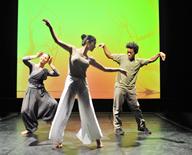 A different tune
A different tune
"A
Different Tune or the Same old Song?" - a paper by Suzanne Burns
Introduction
This is an exciting – if challenging - time for dance. Dance has
never been as understood as an art form as it is at present with government
agendas highlighting both the intrinsic and the extrinsic value of the
form and its ability to contribute to so many leading agendas –
social inclusion, health and well being and education and creativity.
This is also an exciting time in relation to public policy for children
and young people. DCSF agendas on entitlement and access, changing primary
curriculum and the 14-19 reforms are further examples of opportunities
that must be grasped.
At a time of unease and unrest - the economic downturn, the imminent and
likely change of government – it is important that the dance field
speaks with one voice and makes its case for ongoing investment through
clear demonstration of impact and value.
This seminar is an important event in this overall context. It brings
together artists, educators and policy makers from within dance and from
outside the field to consider two interlinked notions that are pertinent
to taking the field forward: the need to consider how we engage children
with dance that is culturally diverse and reflective of the society within
which we live and how we may use digital technology to assist us in doing
so .....
The potential positive outcomes for children engaging with the arts that
are often mentioned can be grouped under three broad types:
• immediate
positive educational, emotional and behavioural benefits for
the children and young people themselves (for example, enjoyment, self
confidence, communication skills, creative thinking)
• potential short- and long-term benefits to wider society (for
example, reduction in crime or anti-social behaviour, an improved economic
situation due to more skilled workforce)
• potential long-term impact on children’s attitudes towards
and engagement with the arts, with potential benefits for the children
(enabling life-long enjoyment of the arts) and the arts sector (building
arts audiences and practitioners for the future)
The recent ACE publication:
Encourage children today to build audiences for tomorrow ... (March 2009)
points to the critical importance of childhood experience in the arts
- cultural socialisation –in relation to active arts consumerism
as an adult. It’s headline findings are perhaps unsurprising:
• being
encouraged to get involved in the arts as a child increases the chances
of being an active arts consumer as an adult
• the effect of childhood experience is very strong, nearing in
magnitude the effect of education – the strongest predictor of
arts engagement
• the level of parental encouragement differs by family background
and personal demographics: parents of high social status are more likely
to encourage their children to engage in the arts; girls and white children
are more likely to receive encouragement than boys and children who
are not white
• this research highlights the importance of initiatives such
as Find Your Talent, which ensure all children have an opportunity to
engage in the arts
• further research is needed on the relative importance of family
and school in influencing life-long patterns of engagement
It is a credit to
Bisakha Sarker, to FUSE and to FACT that this event is taking place. No
one artist has worked as long and as indefatigably as Bisakha furthering
the cause of both South Asian dance and children’s entitlement to
dance.
Dance Mapping Research
Between July 2008 and June 2009, Sue Harrison and myself have been working
on mapping the dance field in all its manifestations. The work has been
fact finding and whilst commissioned by ACE it is for the dance field
and will hopefully assist us all in understanding where we are as we make
strategic decisions on how to move forward into the future. The research
has been extensive but a few key points are pertinent to todays’
debate:
• Dance
is uniquely placed to take advantage of new technology and digitisation.
As a visual medium with some world leaders already pioneering work in
the area, we can grasp the opportunities both to create work and to
develop new means of reaching and engaging audiences
• Dance suffers from a lack of physical infrastructure –
there are few designated spaces for dance relative to other art forms
and this affects the touring and production economy as well as public
engagement. Where partnerships and co-productions are possible between
venues, promoters and artists greater relevance to constituencies of
interest will occur and this has to be a key strategic way forward for
the profession. A Different Tune is a good example of this in action
• Dance and dancing are popular. People love dancing and millions
do so every week and yet audiences for theatre dance remain small. We
must ask ourselves why this is the case? Do we communicate in meaningful
ways to potential audiences? Do we connect with them in ways that make
sense or do we create a sense of marginalisation because of the way
we talk about dance and the dance aesthetic? I am mindful that we are
in a space here that attracts hundreds of people every week to see film
and that this venue and the organisation that runs it is seeking to
make meaningful crossover between the popular film programmes presented
in these screens and the gallery spaces on the ground floor. We must
do the same with dance .....
• Dance is important to young people. It is the second most popular
physical activity after football for young people (according to PESSCL
research) and in the private sector we can estimate that more than 750,000
young people are dancing each week and this starts at the age of 2!
Uneasily placed in schools between PE and Creative/ Performing Arts,
dance is both vulnerable but looked at differently potentially powerfully
placed to effect change.
Increased Investment
in dance by ACE over the period 2008 -11 will support infrastructure development
of more RFOs. But , dance still gets a very small slice of the GfA cake
and must start making stronger and more strategic bids into this competitive
funding strand. ACE Strategy is being developed over the Autumn and the
outcomes of seminars such as this must feed into that process to ensure
that dance policy and strategy reflects true needs.
These are important times and we must work collectively and collaboratively
to take the opportunities they present and move forward with confidence
and strength.
I welcome you here today and hope that you will take something away with
you.....
|



